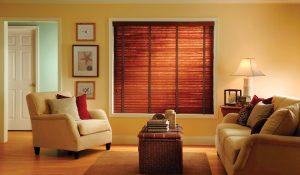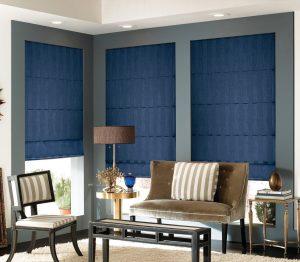 Take a look at your window. Not out your window. At your window. How’s it looking? Has it been tinted to keep out the heat? Is it blocking out light the way you want it to? Is it dressed with blinds, shades, or shutters for privacy? If not, then your home may very well be the victim of unnecessarily high temperatures, UV light damage, and expensive electrical bills—but fear not. These are problems that can be fixed, so unless sweltering heat, damaged furniture, and pricey air conditioning costs are your cup of tea, you may want to look into a window treatment solution for your home. Getting your windows treated by a professional can completely change the look and feel of your home and can save you thousands of dollars in utility costs.
Take a look at your window. Not out your window. At your window. How’s it looking? Has it been tinted to keep out the heat? Is it blocking out light the way you want it to? Is it dressed with blinds, shades, or shutters for privacy? If not, then your home may very well be the victim of unnecessarily high temperatures, UV light damage, and expensive electrical bills—but fear not. These are problems that can be fixed, so unless sweltering heat, damaged furniture, and pricey air conditioning costs are your cup of tea, you may want to look into a window treatment solution for your home. Getting your windows treated by a professional can completely change the look and feel of your home and can save you thousands of dollars in utility costs.
People tend to buy window treatments for one (or more) of three reasons: heat reduction, light reduction, and privacy. Every form of window treatment strives to meet these needs in its own ways, so it’s important to understand how each of these products will function within your home so that you can know which option suits your needs best. In order to do this, you need to consider the layout of the room—or rooms—in which you want to have your window treatment installed. Say, for instance, you’ve purchased some traditional wood blinds to cut down on the amount of light coming into your living room/TV area. Sure, these blinds will block out most incoming light and your room will end up darker and cooler than it was before, but there’s more to it than that. Depending on the position and angle of your windows, your blinds may still allow in some narrow streaks of light which can leave a glare on your television screen. In this instance, rolling shades would likely have been a better option as they would have provided more consistent and even light coverage (and therefore wouldn’t have left streaks on the television screen the way blinds sometimes do). In order to avoid problems like these, make sure that you have a good understanding of how and where light is entering the room so that you can know how to best deal with the situation.
When looking at window treatment options, you may find yourself tempted by the low prices of “big-box” blinds, but don’t be fooled. Yes, it’s true that the blinds, shutters, and shades offered by large home improvement chains are typically less expensive than those provided by window treatment specialists, but what you save in dollars and cents, you lose in quality and specialization. Big-box stores fail to offer the range of high-quality products that specialized local companies do, and while they may offer at-home installation, their services typically lack the level of customization and convenience that installation specialists can offer. If you want to ensure that your window treatments are of a high quality and are installed properly, a professional installer is the way to go. Before installation, of course, you need to consider what product you want for your home.
BLINDS
 With adjustable slats that can be raised or tilted to regulate incoming light, blinds are functional, versatile, and relatively inexpensive. Given the precise and highly-adjustable nature of their design, blinds offer homeowners a greater range of light control than any other window treatment. Whether you want to flood a room with light, drown it in darkness, or go for something in between, blinds give you the power to let in your desired amount of light throughout the day with ease. Keep in mind that this control over light correlates directly with privacy too; the versatility and adjustability of blinds give you complete control over how much (or how little) others can see into your home. This makes them a great tool for guaranteeing you privacy from the outside world and for providing your home with comfort and seclusion.
With adjustable slats that can be raised or tilted to regulate incoming light, blinds are functional, versatile, and relatively inexpensive. Given the precise and highly-adjustable nature of their design, blinds offer homeowners a greater range of light control than any other window treatment. Whether you want to flood a room with light, drown it in darkness, or go for something in between, blinds give you the power to let in your desired amount of light throughout the day with ease. Keep in mind that this control over light correlates directly with privacy too; the versatility and adjustability of blinds give you complete control over how much (or how little) others can see into your home. This makes them a great tool for guaranteeing you privacy from the outside world and for providing your home with comfort and seclusion.
SHADES
 Shades offer simple coverage from heat and light with an elegant, minimalist aesthetic. Unlike blinds, shades don’t have slats or “vanes” to regulate incoming light. Instead, they come in a single, continuous roll of fabric which provides consistent and even light reduction which can be adjusted simply by lowering or raising your shade. Shades come in a variety of styles, including “cellular” shades, which provide reliable insulation and are typically made with translucent fabrics, making them the perfect fit for any room with a light, open aesthetic. Many new lines of shades can be integrated with “smart home” systems including Apple Homekit, Google Home, and Amazon Alexa, which can be controlled with simple voice commands. These innovative systems boast top-of-the-line capabilities and provide you with complete control of your windows through cutting-edge technology.
Shades offer simple coverage from heat and light with an elegant, minimalist aesthetic. Unlike blinds, shades don’t have slats or “vanes” to regulate incoming light. Instead, they come in a single, continuous roll of fabric which provides consistent and even light reduction which can be adjusted simply by lowering or raising your shade. Shades come in a variety of styles, including “cellular” shades, which provide reliable insulation and are typically made with translucent fabrics, making them the perfect fit for any room with a light, open aesthetic. Many new lines of shades can be integrated with “smart home” systems including Apple Homekit, Google Home, and Amazon Alexa, which can be controlled with simple voice commands. These innovative systems boast top-of-the-line capabilities and provide you with complete control of your windows through cutting-edge technology.
SHUTTERS
 Interior shutters can bring a distinctive aesthetic to any room with their classic, timeless style. Shutters are sturdier and more rigid than blinds or shades and comprise multiple rows of adjustable wood or vinyl slats fitted within larger wood or vinyl panels. These slats function in much the same way as those of window blinds—they can be angled together to regulate incoming light—but cannot be raised or lowered the way blinds can. Instead, shutters are swung open on hinges like doors, allowing light to pour in uninhibited. Shutters are a little on the expensive side but will pay for themselves over time through the amount that they’ll save you on energy bills, as they provide reliable insulation when their slats are closed. The gaps between shutters’ slats tend to be wider than those of blinds, making them easier to clean and maintain.
Interior shutters can bring a distinctive aesthetic to any room with their classic, timeless style. Shutters are sturdier and more rigid than blinds or shades and comprise multiple rows of adjustable wood or vinyl slats fitted within larger wood or vinyl panels. These slats function in much the same way as those of window blinds—they can be angled together to regulate incoming light—but cannot be raised or lowered the way blinds can. Instead, shutters are swung open on hinges like doors, allowing light to pour in uninhibited. Shutters are a little on the expensive side but will pay for themselves over time through the amount that they’ll save you on energy bills, as they provide reliable insulation when their slats are closed. The gaps between shutters’ slats tend to be wider than those of blinds, making them easier to clean and maintain.
TINTING
 Whether you choose blinds, shutters, or shades to treat your windows, you should consider supplementing your window treatment with professional tinting. Without window tinting, your blinds, shutters, or shades are completing only a part of a window treatment’s job—they’re blocking out light and some heat, yes, but there’s more that can be done. Tinting is the key to reducing UV light and solar heat. The most popular form of window tinting is the solar window film, which block out up to 99% of incoming UV light, providing your home’s interior with the protection it needs. Reducing ultraviolet light is critical to the preservation and maintenance of your home’s interior, as UV rays can cause permanent fading and damage to your home’s wallpaper, paint, flooring, furniture, and even artwork.
Whether you choose blinds, shutters, or shades to treat your windows, you should consider supplementing your window treatment with professional tinting. Without window tinting, your blinds, shutters, or shades are completing only a part of a window treatment’s job—they’re blocking out light and some heat, yes, but there’s more that can be done. Tinting is the key to reducing UV light and solar heat. The most popular form of window tinting is the solar window film, which block out up to 99% of incoming UV light, providing your home’s interior with the protection it needs. Reducing ultraviolet light is critical to the preservation and maintenance of your home’s interior, as UV rays can cause permanent fading and damage to your home’s wallpaper, paint, flooring, furniture, and even artwork.
Many installers offer a consultation in which you can ask questions to a trained designer who can help you determine what pre-made or custom treatments would work best for your home’s aesthetic. Be sure to ask what warranties the installer provides. Once your blinds, shutters, shades, or tint have been installed, take a look at your newly-treated and insulated window. Not out it. At it. ![]()
Farrell Erickson
Home & Yard Magazine
Special thanks to the professional staff at Budget Blinds of Tallahassee and Super Dave Window Tinting for sharing their time and knowledge.




